The Bagpipe Society
The Story Behind the Carnet de Notes
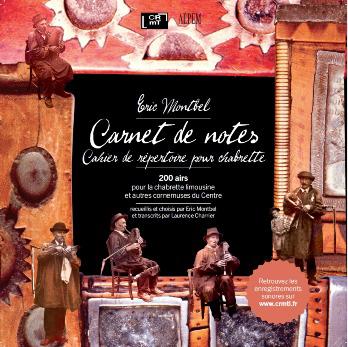
In 2007, we published, in association with CRMT Limousin, the first edition of a book which brought together 200 melodies for the chabrette limousine, as well as for other bagpipes from Central France. The melodies were, for the most part, traditional. The “Carnet de Notes” was immediately successful and it sold out in a few months and it has since become a real collector’s item. Last year the new CRMTL team suggested republishing the book, but in an original way, attaching sound recordings performed by me on the chabrette. So, I took advantage of Covid lockdown to record these 200 melodies in several sessions, in Jacques Lanfranchi’s studio in Burgundy. These tunes can now be accessed online on the CRMTL website, whose address is below¹.
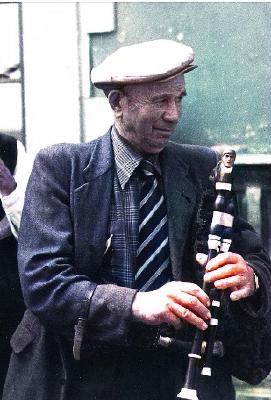
Then came the idea of linking the original sources with these modern recordings, such as I had collected or heard them, as recorded by the interpreters of the traditional world. For me it was interesting to go back to these old sources but also to make the originals available to the general public. It means that everyone can appropriate this repertoire, perhaps propose a new interpretation, but also study the distance between a traditional original and the modern version we gave of it. It should be remembered that the chabrette is an instrument which has been reinvented, even though we have more than 130 surviving models. But I hardly know of any traditional players, with the exception of the three great old ones who I always quote, Louis Jarraud, Camillou Gavinet and André Pangaud. However, three musicians do not make a tradition and, besides, their styles are extremely different. The chabrettes on which they play are themselves instruments of very different tone and manufacture. So, this triple publication - book + traditional sources + modern interpretation, highlights all the steps of recreation that are at work in the revival of traditional music in general and particularly that of the bagpipes of central France. In Great Britain you have the same situation with pastoral pipes, of which we know many models but no living tradition: most contemporary players have revived them by being inspired either by the style of Highland pipes, or by the Northumbrian smallpipes, or uilleann pipes … sometimes by mixing all of these.
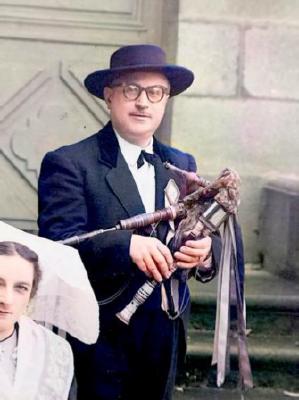
What concerns me, I play a bit of pastoral pipes with a piping inspired by the baroque musette, and it also works. We can clearly see that freedom is without limits, and that there is no authentic truth: only a modern and contemporary approach to prolong a memory, and for the pleasure of plunging into the mystery of history, into the old sound of old instruments. The problem is the same with the chabrette limousine, because I was inspired mainly by the Auvergne cabrette piping, my first bagpipe, which has a real tradition. Cabrette piping was very much alive when I investigated this other musical field. But I had to adapt this plagal drone-less game to an authentic, two-drones bagpipe.

In addition, let’s not forget the educational project of this book, since it allows bagpipers to learn and interpret this repertoire and style by ear, whether or not it is associated with reading the notes.
I began my research for the repertoire of the chabrette limousine with simply restoring melodies for the instrument. In 1976-1977, I was playing the Parisian / Auvergne cabrette, and an old woman in Lyon offered me a strange bagpipe, so beautiful with its mirrors inlaid on the headstock, its drones covered with horn and pewter, its chains … As there was no trace of this instrument in any of the scholarly organological inventories, I wanted to identify it.
The only thing I found was an article by Louis Bonnaud, " Essai sur une chronologie de la cornemuse en Limousin²". Here were two photos of “chabrettes”, described as “old bagpipes in use around Limoges”. Immediately, on my first field trip were my first discoveries: several chabrettes were entrusted to me for repair, I had several collected melodies, and the warm welcome of André Pangaud and Louis Jarraud, chabretaires. The adventure was on the road. In this way, the “hunt” for old tunes started and a way to give this extinct, but fascinating instrument, a chance to be heard again and to regain a place in the contemporary concert. What a sound, what an aesthetic, a poetic beauty!
Craftsmen-artists, with a secret object of art, evocative of memory, of affiliations, of a strange and foreign world. Nothing “folkloric” or reductive here: an opening to the imagination, which had to be fed with airs, dances, hymns, “regrets”. This quest lasted for ten years in an intense way. In 1999, in order to prepare the exhibition “Souffler c’est jouer³”, we presented about forty old chabrettes at the National Museum of Popular Arts and Traditions in Paris, and in Saint-Yrieix-la-Perche, and I had the opportunity to return to these places, to renew contacts, and to collect a few more tunes.
The repertoire
This repertoire was built up from field research in the Limousin. I wrote the diary of my investigations in those years of fever, from approximately 1976 to 1986. Many of the transcribed melodies came from this period and tape recordings also served as my sources. This research work was carried out collectively: whilst the repertoires of the chabrette and chabretaires were my own work of collecting, most of the violin melodies were transmitted to me by my comrades who were also investigating at the same time. For the chabrette, my investigations were mainly accompanied by Pierre Imbert and Thierry Boisvert.
The violin research was conducted mainly by Christian Oller, Olivier Durif, Jean-François Vrod, Jean-Pierre Champeval and Jean-Michel Ponty. The “first-hand” melodies are those that were directly transmitted to me by the chabretaires that I was lucky enough to meet. Sadly, they have now all passed away. Camillou Gavinet, from Saint-Priest-Ligoure, met with my friend Pierre Imbert one evening in March 1978, who was playing the old chabrette built by his grandfather. Louis Jarraud of La Croisille-sur-Briance who used bellows cabrettes “Parisiennes”, but had learned with a chabrette limousine in his childhood. His piping, with drone activated, his repertoire from the chabretaires of La Croisille-sur-Briance strongly marked my first attempts at playing. André Pangaud from Limoges played several limousines. He made us discover a world of urban chabretaires, watchmakers, enamellers, ebonists, in the city of Limoges. These are my three direct “sources” for chabrette piping.
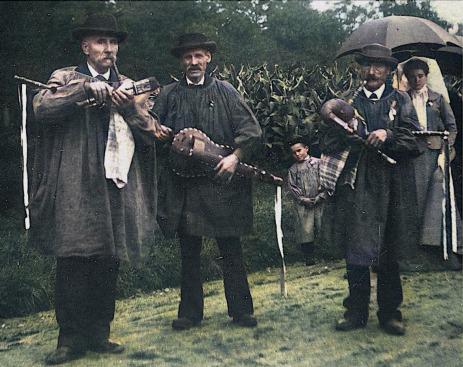
The second source, also important, were the families, the neighbours of chabretaires, and the tunes they sang to me. Until the 1930s, the bagpipe had continued to be played in the Limousin, around Saint-Yrieix-la-Perche, Lubersac, Pompadour, Saint-Bonnet-Briance, Limoges and the testimonies about these musicians remained very alive: the many old photos I found bear witness to this.
The third source is undoubtedly the most important in terms of the quantity of melodies. These are the instrumental repertoires collected in the Limousin: mainly violins, accordions. Here, the fantastic work of my friends from the “Musiciens Routiniers” has made it possible to collect dozens of bourrées, waltzes and other marches. Not all of them are playable by chabrette, that is why I made a technical selection. But, beyond the repertoire, it was the style itself that I was interested in for “building” a limousine chabrette piping.
My fourth source was the instrumental repertoires not used in the Limousin but from areas of close musical cultures: cabrette d’Auvergne, musette du Berry and violin d’Artense for example.
The fifth source was the repertoires of traditional songs from the Limousin. I had the chance to approach great traditional singers, such as Léonard Frachet, Marcelle Delpastre, Marie and Henri Rouland, Marcelle Pathier. Their contribution can be found in this book, especially in the choice I made of their melodies.
My sixth source is written publications, 19th century collections: François Celor‑Pirkin, Casse et Chaminade, Paul Charreire, Branchet and Plantadis⁵ for the most part.
Finally, the last source, perhaps the most fragile and at the same time fundamental for the revival of the instrument, is the recent compositions which we have both ventured on for all these years.
Territory?
Everything leads us to think that these bagpipes were played all over a much larger “territory” than the Limousin before the 19th century, as had undoubtedly been the case in the Auvergne and in a similar way, in Poitou, and in Périgord. Before meeting Camillou Gavinet in 1978, I needed to play the chabrette for three years without any direct indication of the technique or style of the instrument, apart from the friendly and precious advice of André Pangaud, who played rather less then. As a piper, I first looked to Louis Jarraud as he had known former chabretaires and was therefore able to transmit their repertoire.

Although he played some bellows “Parisienne” (Alias and Dufayet), he used the drone in “chanterelle” beside his chanters. I encourage the readers to check the website of CRMTL linked to this publication to hear Louis Jarraud. His style deliberately moved away from that of Auvergne or Parisian players and appeared very unique. But several common traits with the other bagpipes of Center-France emerged in his playing: detached notes from below, what is called “picotage” (“pecking”), as in the playing of cabrette from Paris. Regular vibrato on all upper notes, with one or two fingers, but with total freedom of fingering, in the search for accuracy and expression, depending on each chanter and each key: no standard, no respect for any “school”, only efficiency and expression counting.
We were a long way from the academic “golden rules” of the Auvergne cabrette, as dictated to me by masters like Jean Bergheaud or Pierre Ladonne. Here, a very flowery style, overloaded with flourishes, ornaments, saturated with appoggiaturas sometimes to the detriment of the rhythmic regularity in the dances. But what an expression on Carols, hymns or “regrets”… So with Jarraud, a lot of freedom, in a certain link with a drone bagpipe, drones longtime forgotten in the Auvergne piping. However, the old chabrette’s drone piping seemed to reveal another possibility: that of “plein-jeu”. Le Plein-Jeu and “L’entremain. “Plein-jeu” and “entremain”: these old words come straight from the 17th century method of Borjon de Scellery’s " Traité de la musette". In 1672, this great magistrate published many bagpipe arias that he had collected from minstrels in Bresse. He designated the two possibilities of playing the bagpipe with the words “Plein-Jeu” and “Entremain”. The Plein-Jeu is based on the drone as a tonic, every hole of the chanter is closed except the last one. This is what musicologists call an “authente” tonality, inherited from old ecclesiastical modes. L’Entremain takes the middle of the oboe as the tonic, so the drones sound on a fourth: in other words, the old “plagal” key. Cabrette players use almost exclusively the piping of entremain. With the chabrette, as in the musette de Cour, both ways of piping are possible, Plein Jeu or Entremain.
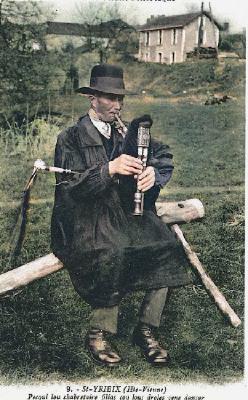
There remains the work on the sound, so important for the expression of music. As any piper knows, it results from a clever mix of fingering (lateral vibrato for instance), quality of the reeds (cane of course!) and air column. It is also an important element of the Auvergne cabrette piping, the bellows replacing the respiratory system. There are many analogies with the cabrette piping, even if the Parisian-Auvergne bagpipe uses bellows. The chabrette limousine appears as an intermediate bagpipe between the musettes of Center-France (16 to 20 “pouces”) and the cabrettes of Auvergne-Paris. I discovered some of the elements of style of the Parisian cabrette in the piping of Louis Jarraud and Camillou Gavinet. But to my immense surprise the Camillou’s piping was using systematically the chabrette’s oboe-pavilion as a rhythmic resonator. Playing seated, Gavinet threw his knee against the pavilion, affecting the air column and transforming the sound into an effect that was both comical and very rhythmically effective, giving his playing a rather unique dynamic. I subsequently used this technique on slow tunes as well as on ternary bourrées. I would never have dared to invent it without this traditional model. According to Camillou, his grandfather did it, and it took the place of vibrato. Listen to it on the tunes on line, it’s quite surprising.
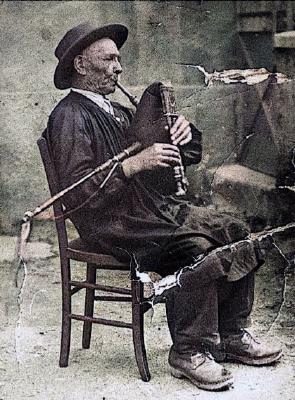
Other reports have told me about this technique in Limousin, or even in the north of Cantal. Expressiveness was one of the qualities sought by chabretaires. Several technical terms are proof to this. For example, this advice given by Charles Gavinet to his grandson to play slow tunes, melodies, regrets: " Fai planher". This means in occitan “Make complain, make cry”. Or on the contrary, the encouragement of François Denis to André Pangaud:
" *Fai dardar, pitit!” * “Make it shine, kid”, but also… “make it climb!” Always some sexual jokes with these bagpipers! The vibrato used by the few traditional chabretaires I met does not seem to obey any written rule: each one adapting his fingering to his chanters and his own piping. Thus, Louis Jarraud vibrates the main note of Entremain (C on a chanter in G) with the middle finger of his right hand. While Gavinet used a lateral vibrato, on the side of the hole, with the index finger: what the cabretaires call the “doigté limagnier”. He got this technique from his neighbour, the famous chabretaire Lo Jai, Pradeau from Château-Chervix (Haute-Vienne). But we know that this Pradeau had stayed in Paris, so we can assume an influence of the piping of the cabretaires of the French capital.
No chabretaire vibrated the lower notes (B, A, G) of the chanter. For me, I adopted the fingering and techniques of the cabrette, my first bagpipe, which I transformed in contact with the drones of the chabrette. The drones bring harmonics and a sound that the Parisian cabrette lacks. Hence, I went looking for other playing techniques of the musette baroque and in particular the “vibré” of the lower notes, by lateral flattering: on the B-hole for a B-vibrate, etc. As for the “vibré” of the last note, I get it by slightly shaking the chanter. Anyone who has seen Asturian gaiteros knows this technique. And I borrowed from the Celtic-era bagpipes (Highland Pipes, Uillean Pipes) their “rolls” and “crans”, on many of our melodies. It is clear that this set of “borrowings” built my piping and the one I was able to pass on; we see that it owes as much to a local affiliation, in Limousin and Auvergne, as to an opening up to Europe.
And the chabrette has always been like this: complex, layered, built from multiple influences.
Fiddlers and Chabretaires
My first encounter with a fiddler, a “violoneux” as we say, was with Antonin Chabrier, in January 1975 or 1976. I asked him if he played “medieval branles” and he replied: “The socket for the tape recorder is here”. There were some big gaps in my “trad” culture at the time. Faced with this linked, legato, linear, back and forth, slow and choreographic bow playing, I sensed the connection with the playing of the bagpipes. This man was piping… on the violin. Please listen to this incredible musician on the website. I had the same shock much later with Alfred Mouret in Artense. Much has been said since the 19th century about the place that violins would have taken, replacing the “ancient” bagpipes and hurdy-gurdies in the countryside of the Massif Central. Maybe. Hearing Chastagnol, Chabrier, Péchadre or Mouret performing at the end of the 20th century was always a visual, sound and social experience, which had nothing to do with the classical violin and the folk accordion. Playing on drones, using open strings. The ornaments. And the sound, the work on the sound, as we can also hear at Bouscatel or Bergheaud, the immense cabretaires of the old Parisian cabrette school. On the violin, as on the bagpipe, the sound is not made, it does not come out of the instrument formatted, unlike a piano or an accordion, for example. The musician makes the sound; the fingers, the breath or the bow, affirm the accuracy, the expression, the height: ungrateful instruments, which do not support approximations. Add to this the rhythmic and supple footwork, dancing seated. And this linear bow, these melodies in joint degrees so evocative of the bagpipe. In 1728, the musician Demoz de la Salle wrote about the “louré” style: “Lourer is to express the notes which are linked from two to two, by flowing, stroking, and rolling, so that the sounds be continuous, linked and conjoined, like those of the tunes of instruments called musettes, bagpipes, hurdy-gurdies”. Mouret’s or Chabrier’s “louré” playing remains for me a great traditional model, referring to the playing of the bagpipe as well as the playing of the violin.
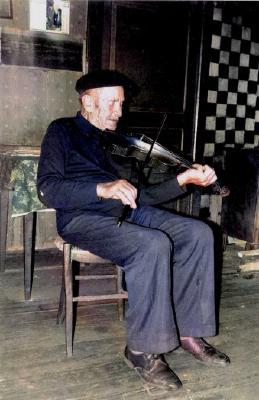
The immense work on the Corrézian violin carried out by the " Musiciens Routiniers⁵ ʺ has brought to light dozens of bourrées. All of them would be playable with the chabrette, but our instruments have a scale of no more than one octave. Sometimes only one note is missing. Yet the scale and range of these violin melodies mimic those of our bagpipes, whether they are Plein- Jeu or Entremain melodies. Is this a coincidence? Obviously not: these are cultural traits, both technical and aesthetic, but which signify a definitive kinship. And then some fiddlers have known chabretaires: Peyrat, Ceppe, Jabut, Malthieux for example, who transmitted their melodies to us. The violin tunes have been (and doubtless will be) bagpipe tunes, coming from the same territory, the same networks of musicians who have shaped what we call a tradition. Therefore, we find a good number of their bourrées, all playable on the chabrette as long as we use the chromatic fingering which brings the sub-tonic back to a whole tone. This technique, ignored by Gavinet for example, sounds naturally on the chanters of Louis Jarraud: you can hear almost an entire tone in its sub-tonics, as it is customary on Parisian cabrettes. This possibility of using chromaticism allowed us to play the limousine chabrette in different modes, adopting many melodies in minor. I have not collected a single minor tune in the repertoire of former chabretaires: but as the luthier Claude Girard very rightly pointed out, this possibility exists on the instrument, it was certainly used and it would be very frustrating to deprive ourselves of it today.
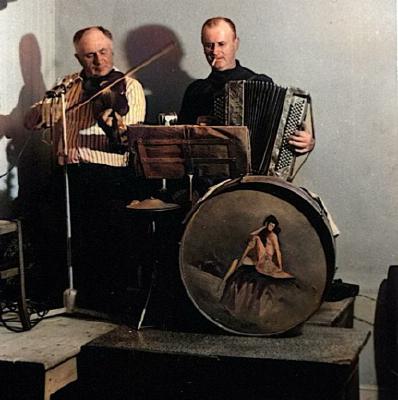
This opens up the immense field of composition, which pushes back the limits of the transmitted tradition, to integrate both song melodies, violin, accordion and hurdy-gurdy tunes, and new creations.
A final word about my own recordings available on this website. I usually use chabrettes in B flat, which stays a common tonality of the old instruments we found. Almost all my earlier recordings before this (as in the album of Lo Jai or in my CD “Chabretas”) are done with this high tonality of B flat which I love. But it is true that several other tonalities are in the range of the old chabrettes that we found, from a low E flat, to the highest D. As the printed publications of the tunes have been made in G, the CRMTL asked me to play and record in this tonality, certainly more pedagogical and easy to follow for students or people learning by ear, even if this colour is not my favourite. So, open the book, click on the website, listen to the tunes and enjoy!
Translated with the grateful help of my beloved Karin, and kindly “Anglicized” by Jane Moulder.
See more at https://www.ericmontbel.com
The “Carnet de Notes” can be ordered from AEPEM: aepem.com All photos in the article are in Eric Montbel’s collection.
¹ https://crmtl.fr/actions/publications/partitions-livres/cahier-de-chabrette/ If you prefer the sound-on-ly version, it is possible to listen to the recordings in streaming here: https://open.audio/library/artists/15523/
² L. BONNAUD, “Essai sur une chronologie de la cornemuse en Limousin”, BSAH Limousin, XCIV, 1967, p. 207-229.
³ « Souffler c’est Jouer. Chabretaires et cornemuses à miroirs en Limousin ». 1999, Modal, sous la direction de Florence Gétreau et Eric Montbel.
⁴ These authors have all published collections of songs and dance tunes collected in Limousin in the 19th century. They were not playing this type of music, but were involved in “regionalism” and politics movements, mainly conservative. Casse et Chaminade were two catholic priests, so they mainly published… folk canticles!
⁵ Les “Musiciens Routiniers” was an association we created in Lyon around 1978 with my band “Le Grand Rouge”, in order to bring together young musicians who were investigating the music of the Massif Central. We created the Modal review, published albums of field recordings, organized workshops, etc. This organization is at the origin of the “Centres des Musiques Traditionnelles” in France, known today as FAMDT.
- Data Processing Notice (GDPR)
-
@BagpipeSociety on X (formally known as Twitter)
-
TheBagpipeSociety on Instagram
-
 BagpipeSociety on Facebook
BagpipeSociety on Facebook
Something wrong or missing from this page? Let us know!
